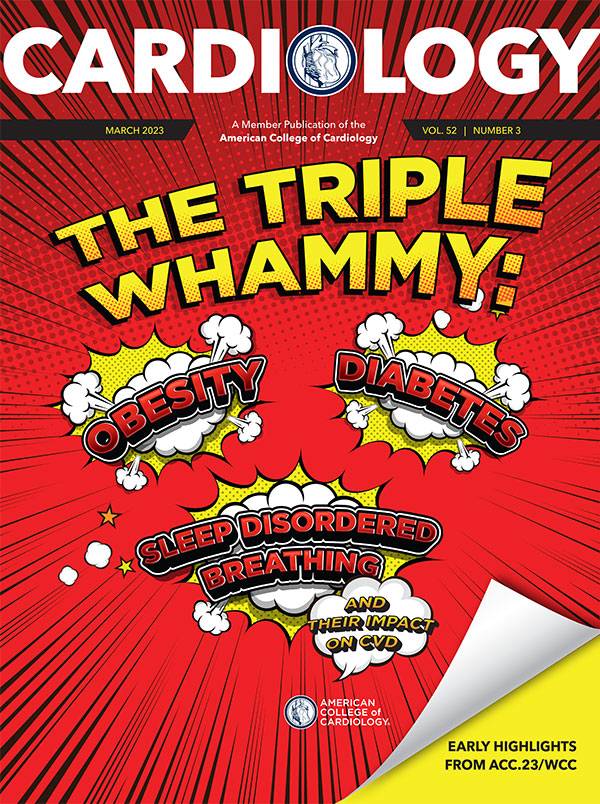Peripheral Matters | What Do the BEST-CLI Results Mean For Practice?

It is estimated that peripheral arterial disease (PAD) affects over 12 million Americans.1 Critical limb ischemia (CLI), which is characterized by rest pain with or without tissue loss, is the most severe end of the PAD spectrum. About 11% of patients with PAD have CLI.2 Treatment for CLI requires aggressive revascularization strategies to minimize the risk of amputation.
The BASIL trial, published in 2005, demonstrated similar outcomes for the primary endpoint of amputation-free survival with surgical bypass and endovascular angioplasty in its prospective, randomized, controlled comparison.3 A later analysis from BASIL reported better overall survival in those patients who survived at least two years after randomization and had undergone surgical bypass vs. endovascular angioplasty.4
Since then, new techniques and devices have become available, providing clinicians and patients numerous options to tackle PAD. However, how these new strategies impacted clinical outcomes was unknown. The BEST-CLI trial endeavored to answer this question.5
BEST-CLI Trial Design
The international Best-CLI trial randomized 1,830 patients with CLI to two parallel cohorts. Cohort 1 comprised patients with a single segment of great saphenous vein (GSV) that could be used for surgery. Cohort 2 comprised patients without a suitable GSV and required an alternative bypass conduit.
The primary outcome was a composite of major adverse limb events (MALE), defined as amputation above the ankle or a major limb intervention (a new bypass graft or graft revision, thrombectomy, or thrombolysis) and all-cause mortality. Outcomes were determined using an intention-to-treat analysis.
Patients were enrolled from 2014 to 2019. Enrollment ended early due to a lack of continued funding. Of the anticipated 2,100 patients (1,620 in Cohort 1 and 480 in Cohort 2) needed for enrollment, 1,830 were ultimately enrolled (1,434 in Cohort 1 and 396 in Cohort 2). The median follow-up for Cohort 1 was 2.7 years, but only 1.6 years for Cohort 2.
Findings From BEST-CLI
No difference in the primary endpoint was found between surgical bypass and endovascular revascularization in Cohort 2. In contrast, patients in Cohort 1 had significantly fewer primary outcome events vs. those in the endovascular treatment group. The surgery-first strategy was found to have a 32% lower risk of a composite of MALE or death than the endovascular strategy. Secondary outcomes including all-cause mortality, amputation, intervention of the index limb, perioperative death and cardiovascular events such as myocardial infarction and stroke were similar between both treatment groups. The bypass group had a longer hospital stay of 6 days vs. 3 days for the endovascular group.
Strengths of Best-CLI
Best-CLI is the largest and most current randomized clinical trial to compare surgical and endovascular therapy for CLI. The investigation puts forth compelling data to suggest that surgical bypass is the optimal initial strategy in CLI patients with a suitable GSV conduit. For patients lacking a suitable GSV conduit, the findings reinforce the importance of careful, informed decision-making prior to choosing a revascularization therapy.
Controversies
As with all clinical studies, BEST-CLI has its share of limitations leading to controversies over the results. Perhaps the biggest issue is centered around the high rate of failed endovascular procedures in Cohort 1. While technical failure in the surgical group was <2%, the initial failure rate in the endovascular group was >5%, worse than the <10% reported in contemporary literature.6,7 This raises questions about the endovascular strategies employed by investigators. Other studies have shown the risk of major amputation is similar between surgery and endovascular revascularization when both procedures are performed at high-volume centers.8
There was a high rate of early reintervention in the endovascular group of Cohort 1. Of the 233 first reintervention procedures, 99 (42.5%) events occurred within 30 days. The short time to repeat intervention suggests technical failure of the index procedure, but the contribution of insufficient revascularization remains unknown because of the lack of angiographic core lab adjudication.
A close examination of trial data revealed considerable heterogeneity in endovascular techniques used, including angioplasty and stent implantation with or without drug elution, covered stents placement and atherectomy. The device and technique used was left to the clinical judgment of the operators. While this may emulate real-world practice, this methodology no longer compares a single treatment to another, but rather, one treatment is assessed against a variety of similar but not necessarily equivalent therapies.
The limited use of drug-coated devices was another subject of concern. For example, of the patients who received endovascular treatment of a superficial femoral artery lesion in Cohort 1, only 16.5% received a drug-eluting stent and 18.5% were treated with a drug-coated balloon. The number of patients treated with both devices at the index procedure is unknown. The authors noted that a meta-analysis published in December 2018 raised concerns about a potentially increased risk of death associated with paclitaxel-coated devices, which may have reduced their use in BEST-CLI.9 However, the meta-analysis was published towards the end of the enrollment period after most patients would have been enrolled.
Future Directions
Questions remain about the best treatment strategy for patients with CLI. While bypass may be considered the optimal surgical option, the varied endovascular techniques and devices used in BEST-CLI make it difficult to conclude surgery is truly superior. A need remains for studies to compare a single surgical treatment with a single endovascular treatment plan. Core lab adjudication is necessary to add standardization and enable review of procedures associated with early adverse events. Operator assessment of reperfusion has been shown to overestimate success vs. core lab review.10
There was a relatively small number of participating interventional radiologists and cardiologists. A future study should strive to include interventionalists who better resemble current practice. Lastly, it is unclear what proportion of the CLI population would be candidates for BEST-CLI. Enrollment criteria required reasonable surgical risk and anatomy suitable for both bypass and endovascular treatment. Thus it may represent only a fraction of the CLI population, hence the struggle to achieve full enrollment.
Conclusions
Surgical bypass and endovascular therapy are effective options for treating CLI. The BEST-CLI trial offers new data to support initial surgery for patients with a suitable GSV conduit. However, more research is needed to validate surgery against optimal endovascular strategies. Core lab adjudication is necessary to understand why a procedure failed if it does and generalizability studies to examine the potential impact of this focused trial on real-world CLI patients. Ultimately, patient-level decision making is of utmost importance when treating CLI.



This article was authored by Edwin Takahashi, MD, Division of Vascular and Interventional Radiology, Mayo Clinic, Rochester, MN; Eric A. Secemsky, MD, MSc, FACC, Richard A. and Susan F. Smith Center for Outcomes Research in Cardiology, Division of Cardiovascular Medicine, Beth Israel Deaconess Medical Center, Boston, MA; and Sanjay Misra, MD, Division of Vascular and Interventional Radiology, Mayo Clinic.
References
- Misra S, Shishehbor MH, Takahashi EA, et al. Perfusion assessment in critical limb ischemia: Principles for understanding and the development of evidence and evaluation of devices: A scientific statement from the American Heart Association. Circulation 2019;140:e657-e72.
- Conte MS, Bradbury AW, Kolh P, et al. Global vascular guidelines on the management of chronic limb-threatening ischemia. J Vasc Surg 2019;69:3S-125S.
- Adam DJ, Beard JD, Cleveland T, et al. Bypass versus angioplasty in severe ischaemia of the leg (BASIL): multicentre, randomised controlled trial. Lancet 2005;366:1925-34.
- Bradbury AW, Adam DJ, Bell J, et al. Bypass versus angioplasty in severe ischaemia of the leg (BASIL) trial: An intention-to-treat analysis of amputation-free and overall survival in patients randomized to a bypass surgery-first or a balloon angioplasty-first revascularization strategy. J Vasc Surg 2010;51(5 Suppl):5S-17S.
- Farber A, Menard MT, Conte MS, et al. Surgery or endovascular therapy for chronic limb-threatening ischemia. N Engl J Med 2022;387:2305-16.
- Iida O, Takahara M, Soga Y, et al. Three-year outcomes of surgical versus endovascular revascularization for critical limb ischemia: The SPINACH study (surgical reconstruction versus peripheral intervention in patients with critical limb ischemia). Circ Cardiovasc Interv 2017;10(12):e005531.
- Giannopoulos S, Palena LM, Armstrong EJ. Technical success and complication rates of retrograde arterial access for endovascular therapy for critical limb ischaemia: A systematic review and meta-analysis. Eur J Vasc Endovasc Surg 2021;61:270-9.
- Majmundar M, Patel KN, Doshi R, et al. Comparison of 6-month outcomes of endovascular vs surgical revascularization for patients with critical limb ischemia. JAMA Netw Open 2022;5:e2227746.
- Katsanos K, Spiliopoulos S, Kitrou P, et al. Risk of death following application of paclitaxel-coated balloons and stents in the femoropopliteal artery of the leg: A systematic review and meta-analysis of randomized controlled trials. J Am Heart Assoc 2018;7:e011245.
- Zhang G, Treurniet KM, Jansen IGH, et al. Operator versus core lab adjudication of reperfusion after endovascular treatment of acute ischemic stroke. Stroke 2018;49:2376-82.
Clinical Topics: Cardiac Surgery, Cardiovascular Care Team, Invasive Cardiovascular Angiography and Intervention, Prevention, Vascular Medicine, Atherosclerotic Disease (CAD/PAD), Aortic Surgery, Cardiac Surgery and Arrhythmias, Interventions and Vascular Medicine
Keywords: ACC Publications, Cardiology Magazine, Aneurysm, Drug-Eluting Stents, Ocimum basilicum, Saphenous Vein, Intention to Treat Analysis, Cardiologists, Ankle, Paclitaxel, Prospective Studies, Follow-Up Studies, Secondary Prevention, Random Allocation, Peripheral Arterial Disease, Endovascular Procedures, Atherectomy, Reperfusion, Thrombectomy, Angioplasty, Ischemia, Radiologists, Reference Standards, Decision Making, Thrombolytic Therapy, Infarction, Randomized Controlled Trials as Topic
< Back to Listings

